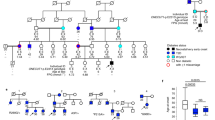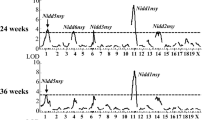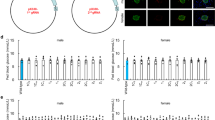Abstract
We previously mapped the type 2 diabetes mellitus-2 locus (T2dm2), which affects fasting insulin levels, to distal chromosome 19 in a leptin-deficient obese F2 intercross derived from C57BL/6 (B6) and BTBR T+ tf/J (BTBR) mice1. Introgression of a 7-Mb segment of the B6 chromosome 19 into the BTBR background (strain 1339A) replicated the reduced insulin linked to T2dm2. The 1339A mice have markedly impaired insulin secretion in vivo and disrupted islet morphology. We used subcongenic strains derived from 1339A to localize the T2dm2 quantitative trait locus (QTL) to a 242-kb segment comprising the promoter, first exon and most of the first intron of the Sorcs1 gene. This was the only gene in the 1339A strain for which we detected amino acid substitutions and expression level differences between mice carrying B6 and BTBR alleles of this insert, thereby identifying variation within the Sorcs1 gene as underlying the phenotype associated with the T2dm2 locus. SorCS1 binds platelet-derived growth factor, a growth factor crucial for pericyte recruitment to the microvasculature, and may thus have a role in expanding or maintaining the islet vasculature. Our identification of the Sorcs1 gene provides insight into the pathway underlying the pathophysiology of obesity-induced type 2 diabetes mellitus.
This is a preview of subscription content, access via your institution
Access options
Subscribe to this journal
Receive 12 print issues and online access
$209.00 per year
only $17.42 per issue
Buy this article
- Purchase on Springer Link
- Instant access to full article PDF
Prices may be subject to local taxes which are calculated during checkout




Similar content being viewed by others
References
Stoehr, J.P. et al. Genetic obesity unmasks nonlinear interactions between murine type 2 diabetes susceptibility loci. Diabetes 49, 1946–1954 (2000).
Bell, G.I. & Polonsky, K.S. Diabetes mellitus and genetically programmed defects in beta-cell function. Nature 414, 788–791 (2001).
Rhodes, C.J. Type 2 diabetes-a matter of beta-cell life and death? Science 307, 380–384 (2005).
Florez, J.C., Hirschhorn, J. & Altshuler, D. The inherited basis of diabetes mellitus: implications for the genetic analysis of complex traits. Annu. Rev. Genomics Hum. Genet. 4, 257–291 (2003).
Permutt, M.A., Wasson, J. & Cox, N. Genetic epidemiology of diabetes. J. Clin. Invest. 115, 1431–1439 (2005).
Parikh, H. & Groop, L. Candidate genes for type 2 diabetes. Rev. Endocr. Metab. Disord. 5, 151–176 (2004).
Barroso, I. et al. Candidate gene association study in type 2 diabetes indicates a role for genes involved in beta-cell function as well as insulin action. PLoS Biol. 1, E20 (2003).
Clee, S.M., Nadler, S.T. & Attie, A.D. Genetic and genomic studies of the BTBR ob/ob mouse model of type 2 diabetes. Am. J. Ther. 12, 491–498 (2005).
Hermey, G. et al. Characterization of Sorcs1, an alternatively spliced receptor with completely different cytoplasmic domains that mediate different trafficking in cells. J. Biol. Chem. 278, 7390–7396 (2003).
Hampe, W., Rezgaoui, M., Hermans-Borgmeyer, I. & Schaller, H.C. The genes for the human VPS10 domain-containing receptors are large and contain many small exons. Hum. Genet. 108, 529–536 (2001).
Hermey, G., Sjogaard, S., Petersen, C.M., Nykjaer, A. & Gliemann, J. Tumour necrosis factor-alpha convertase mediates ectodomain shedding of Vps10p-domain receptor family members. Biochem. J. 395, 285–293 (2006).
Song, S., Ewald, A.J., Stallcup, W., Werb, Z. & Bergers, G. PDGFRβ+ perivascular progenitor cells in tumours regulate pericyte differentiation and vascular survival. Nat. Cell Biol. 7, 870–879 (2005).
Abramsson, A., Lindblom, P. & Betsholtz, C. Endothelial and nonendothelial sources of PDGF-B regulate pericyte recruitment and influence vascular pattern formation in tumors. J. Clin. Invest. 112, 1142–1151 (2003).
Lammert, E. et al. Role of VEGF-A in vascularization of pancreatic islets. Curr. Biol. 13, 1070–1074 (2003).
Brissova, M. et al. Intraislet endothelial cells contribute to revascularization of transplanted pancreatic islets. Diabetes 53, 1318–1325 (2004).
Jacobsen, L. et al. Activation and functional characterization of the mosaic receptor SorLA/LR11. J. Biol. Chem. 276, 22788–22796 (2001).
Munck Petersen, C. et al. Propeptide cleavage conditions sortilin/neurotensin receptor-3 for ligand binding. EMBO J. 18, 595–604 (1999).
Westergaard, U.B. et al. Sorcs3 does not require propeptide cleavage to bind nerve growth factor. FEBS Lett. 579, 1172–1176 (2005).
Westergaard, U.B. et al. Functional organization of the sortilin Vps10p-domain. J. Biol. Chem. 279, 50221–50229 (2004).
Duggirala, R. et al. Linkage of type 2 diabetes mellitus and of age at onset to a genetic location on chromosome 10q in Mexican Americans. Am. J. Hum. Genet. 64, 1127–1140 (1999).
Galli, J. et al. Genetic analysis of non-insulin dependent diabetes mellitus in the GK rat. Nat. Genet. 12, 31–37 (1996).
Kim, J.H. et al. Genetic analysis of a new mouse model for non-insulin-dependent diabetes. Genomics 74, 273–286 (2001).
Kluge, R. et al. Quantitative trait loci for obesity and insulin resistance (Nob1, Nob2) and their interaction with the leptin receptor allele (LeprA720T/T1044I) in New Zealand obese mice. Diabetologia 43, 1565–1572 (2000).
Wiltshire, S. et al. A genomewide scan for loci predisposing to type 2 diabetes in a U.K. population (the Diabetes UK Warren 2 Repository): analysis of 573 pedigrees provides independent replication of a susceptibility locus on chromosome 1q. Am. J. Hum. Genet. 69, 553–569 (2001).
Wei, S. et al. Mapping and characterization of quantitative trait loci for non-insulin-dependent diabetes mellitus with an improved genetic map in the Otsuka Long-Evans Tokushima fatty rat. Mamm. Genome 10, 249–258 (1999).
Rabaglia, M.E. et al. Alpha-ketoisocaproate-induced hypersecretion of insulin by islets from diabetes-susceptible mice. Am. J. Physiol. Endocrinol. Metab. 289, E218–E224 (2005).
Liu, Y. & Zeng, Z.B. A general mixture model approach for mapping quantitative trait loci from diverse cross designs involving multiple inbred lines. Genet. Res. 75, 345–355 (2000).
Zou, F., Yandell, B.S. & Fine, J.P. Statistical issues in the analysis of quantitative traits in combined crosses. Genetics 158, 1339–1346 (2001).
Broman, K.W., Wu, H., Sen, S. & Churchill, G.A. R/qtl: QTL mapping in experimental crosses. Bioinformatics 19, 889–890 (2003).
Churchill, G.A. & Doerge, R.W. Empirical threshold values for quantitative trait mapping. Genetics 138, 963–971 (1994).
Acknowledgements
This work was supported by US National Institute of Diabetes and Digestive and Kidney Diseases grants 58037 and 66369 to A.D.A.; American Heart Association postdoctoral fellowships 0325480Z and 0525688Z to S.M.C.; grants from the US Department of Agriculture's Cooperative State Research, Education and Extension Service to B.S.Y. and A.D.A.; a Sponsored Research Agreement with Xenon Pharmaceuticals (formerly Xenon Genetics) and an American Diabetes Association Mentor-Based Fellowship to A.D.A. We thank W.F. Dove for his advice and encouragement throughout this project, A. Steinberg for his expert assistance in preparing the figures for this manuscript and the staff in our animal care facility for their dedication to this work.
Author information
Authors and Affiliations
Corresponding author
Ethics declarations
Competing interests
The authors declare no competing financial interests.
Supplementary information
Supplementary Table 1
Phenotypic characterization of female 1339A congenic mice. (PDF 21 kb)
Supplementary Table 2
Sequence and expression analysis of genes in the 1339A strain. (PDF 30 kb)
Supplementary Table 3
Primers used for sequencing, quantitative RT-PCR and marker genotyping. (PDF 22 kb)
Rights and permissions
About this article
Cite this article
Clee, S., Yandell, B., Schueler, K. et al. Positional cloning of Sorcs1, a type 2 diabetes quantitative trait locus. Nat Genet 38, 688–693 (2006). https://doi.org/10.1038/ng1796
Received:
Accepted:
Published:
Issue Date:
DOI: https://doi.org/10.1038/ng1796
This article is cited by
-
Genetic susceptibility to diabetic kidney disease is linked to promoter variants of XOR
Nature Metabolism (2023)
-
Finding memo: versatile interactions of the VPS10p-Domain receptors in Alzheimer’s disease
Molecular Neurodegeneration (2022)
-
Reaffirmation of known major genes and the identification of novel candidate genes associated with carcass-related metrics based on whole genome sequence within a large multi-breed cattle population
BMC Genomics (2019)
-
Type 2 diabetes-associated single nucleotide polymorphism in Sorcs1 gene results in alternative processing of the Sorcs1 protein in INS1 β-cells
Scientific Reports (2019)
-
Fast genetic mapping of complex traits in C. elegans using millions of individuals in bulk
Nature Communications (2019)



